| Listing 1 - 10 of 25 | << page >> |
Sort by
|
Book
ISBN: 9781118923139 9781119011910 9781119011903 Year: 2015 Publisher: New York : Wiley
Abstract | Keywords | Export | Availability | Bookmark
 Loading...
Loading...Choose an application
- Reference Manager
- EndNote
- RefWorks (Direct export to RefWorks)
The second edition enhanced with new chapters, figures, and appendices to cover the new developments in applied mathematical functions This book examines the topics of applied mathematical functions to problems that engineers and researchers solve daily in the course of their work. The text covers set theory, combinatorics, random variables, discrete and continuous probability, distribution functions, convergence of random variables, computer generation of random variates, random processes and stationarity concepts with associated autocovariance and cross covariance functions, estimation theory and Wiener and Kalman filtering ending with two applications of probabilistic methods. Probability tables with nine decimal place accuracy and graphical Fourier transform tables are included for quick reference. The author facilitates understanding of probability concepts for both students and practitioners by presenting over 450 carefully detailed figures and illustrations, and over 350 examples with every step explained clearly and some with multiple solutions. Additional features of the second edition of Probability and Random Processes are: Updated chapters with new sections on Newton-Pepys'problem; Pearson, Spearman, and Kendal correlation coefficients; adaptive estimation techniques; birth and death processes; and renewal processes with generalizations A new chapter on Probability Modeling in Teletraffic Engineering written by Kavitha Chandra An eighth appendix examining the computation of the roots of discrete probability-generating functions With new material on theory and applications of probability, Probability and Random Processes, Second Edition is a thorough and comprehensive reference for commonly occurring problems in probabilistic methods and their applications.

ISBN: 0226789551 0226789578 9780226789583 0226789586 9780226789552 9780226789552 9780226789576 9780226789576 Year: 2004 Publisher: Chicago (Ill.) : University of Chicago press,
Abstract | Keywords | Export | Availability | Bookmark
 Loading...
Loading...Choose an application
- Reference Manager
- EndNote
- RefWorks (Direct export to RefWorks)
An exploration of the statistical foundations of scientific inference, The Nature of Scientific Evidence asks what constitutes scientific evidence and whether scientific evidence can be quantified statistically. Mark Taper, Subhash Lele, and an esteemed group of contributors explore the relationships among hypotheses, models, data, and inference on which scientific progress rests in an attempt to develop a new quantitative framework for evidence. Informed by interdisciplinary discussions among scientists, philosophers, and statisticians, they propose a new ""evidential"" approach,
Statistics as Topic --- Science --- Sciences --- methods --- Statistical methods. --- Methodology. --- Méthodes statistiques --- Méthodologie --- Science - Methodology. --- Science -- Methodology. --- Science - Statistical methods. --- Science -- Statistical methods. --- Science -- Study and teaching. --- Physical Sciences & Mathematics --- Sciences - General --- Méthodes statistiques --- Méthodologie --- methods.
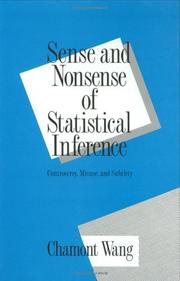
ISBN: 0824787986 Year: 1993 Volume: vol 6 Publisher: New York Basel Hong Kong Marcel Dekker
Abstract | Keywords | Export | Availability | Bookmark
 Loading...
Loading...Choose an application
- Reference Manager
- EndNote
- RefWorks (Direct export to RefWorks)
Mathematical statistics --- Statistique mathématique --- Wiskundige statistiek --- Mathematical statistics. --- Science --- Philosophy. --- Statistical methods. --- Statistical methods --- Philosophy --- Science - Statistical methods. --- Science - Philosophy.
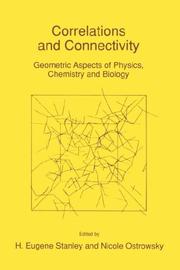
ISBN: 0792310101 079231011X 9400921578 9780792310105 Year: 1990 Volume: 188 Publisher: Dordrecht: Kluwer Academic Publishers,
Abstract | Keywords | Export | Availability | Bookmark
 Loading...
Loading...Choose an application
- Reference Manager
- EndNote
- RefWorks (Direct export to RefWorks)
Correlation (Statistics) --- Constraints (Physics) --- Science --- Congresses. --- Statistical methods --- Geometry --- Congresses --- Correlation (Statistics) - Congresses. --- Constraints (Physics) - Congresses. --- Science - Statistical methods - Congresses.
Book
ISBN: 9781442249929 9781442249936 1442249927 1442249935 Year: 2016 Publisher: Lanham
Abstract | Keywords | Export | Availability | Bookmark
 Loading...
Loading...Choose an application
- Reference Manager
- EndNote
- RefWorks (Direct export to RefWorks)
This book is arranged in 17 chapters, which are organized into five main sections: the first section introduces research design and data collection ; the second section discusses basic statistical concepts, including descriptive, bivariate, time series, and regression analyses ; section 3 covers the subject of visualization creation using Open Source R ; section 4 covers decision making from the analysis ; and the last section provides examples and references.
Programming --- Statistical science --- Library research --- Information science --- Library statistics --- R (Computer program language) --- Information visualization --- Statistical methods --- Information science - Statistical methods --- Library statistics. --- Information visualization. --- Statistical methods.
Book
ISBN: 0444704256 Year: 1988 Publisher: Amsterdam : Elsevier science,
Abstract | Keywords | Export | Availability | Bookmark
 Loading...
Loading...Choose an application
- Reference Manager
- EndNote
- RefWorks (Direct export to RefWorks)
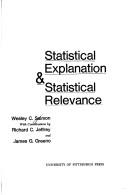
ISBN: 0822952254 1306847893 0822974118 9780822974116 9780822952251 Year: 1971 Volume: 69 Publisher: [Pittsburgh] University of Pittsburgh Press
Abstract | Keywords | Export | Availability | Bookmark
 Loading...
Loading...Choose an application
- Reference Manager
- EndNote
- RefWorks (Direct export to RefWorks)
Through his S-R model of statistical relevance, Wesley Salmon offers a solution to the scientific explanation of objectively improbable events. Two other essays compliment the statisticl relevance model.
Science --- Mathematical statistics --- Statistical methods --- -Mathematics --- Statistical inference --- Statistics, Mathematical --- Statistics --- Probabilities --- Sampling (Statistics) --- Natural science --- Science of science --- Sciences --- Mathematics --- Mathematical statistics. --- Statistical methods. --- Science - Statistical methods
Book
ISBN: 0063503727 0060436336 Year: 1985 Publisher: New York London Sydney Harper & Row
Abstract | Keywords | Export | Availability | Bookmark
 Loading...
Loading...Choose an application
- Reference Manager
- EndNote
- RefWorks (Direct export to RefWorks)
Engineering --- Science --- Statistical methods. --- Statistical methods --- Engineering - Statistical methods. --- Science - Statistical methods. --- Fiabilité --- Statistique --- Statistics --- Méthodes statistiques. --- Méthodes graphiques. --- Graphic methods --- Fiabilité --- Méthodes statistiques. --- Méthodes graphiques.
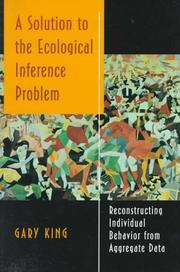
ISBN: 0691012407 0691012415 1400849209 9781400849208 9780691012414 9780691012407 1299840760 Year: 1997 Publisher: Princeton, NJ
Abstract | Keywords | Export | Availability | Bookmark
 Loading...
Loading...Choose an application
- Reference Manager
- EndNote
- RefWorks (Direct export to RefWorks)
This book provides a solution to the ecological inference problem, which has plagued users of statistical methods for over seventy-five years: How can researchers reliably infer individual-level behavior from aggregate (ecological) data? In political science, this question arises when individual-level surveys are unavailable (for instance, local or comparative electoral politics), unreliable (racial politics), insufficient (political geography), or infeasible (political history). This ecological inference problem also confronts researchers in numerous areas of major significance in public policy, and other academic disciplines, ranging from epidemiology and marketing to sociology and quantitative history. Although many have attempted to make such cross-level inferences, scholars agree that all existing methods yield very inaccurate conclusions about the world. In this volume, Gary King lays out a unique--and reliable--solution to this venerable problem. King begins with a qualitative overview, readable even by those without a statistical background. He then unifies the apparently diverse findings in the methodological literature, so that only one aggregation problem remains to be solved. He then presents his solution, as well as empirical evaluations of the solution that include over 16,000 comparisons of his estimates from real aggregate data to the known individual-level answer. The method works in practice. King's solution to the ecological inference problem will enable empirical researchers to investigate substantive questions that have heretofore proved unanswerable, and move forward fields of inquiry in which progress has been stifled by this problem.
Conclusie --- Conclusion --- Gevolgtrekking --- Inference --- Inference (Logic) --- Political statistics --- #SBIB:303H10 --- #SBIB:003.IO --- Ampliative induction --- Induction, Ampliative --- Reasoning --- Political science --- Statistics --- Methoden en technieken: algemene handboeken en reeksen --- Statistical methods --- Inference. --- Political statistics. --- Political science - Statistical methods.
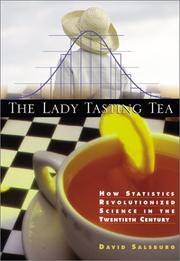
ISBN: 0716741067 9780805071344 0805071344 9780716741060 Year: 2002 Publisher: New York (N.Y.): Freeman,
Abstract | Keywords | Export | Availability | Bookmark
 Loading...
Loading...Choose an application
- Reference Manager
- EndNote
- RefWorks (Direct export to RefWorks)
Science --- Statistical methods --- History --- 5 <09> --- 303 --- #KVHA:Methodologie --- #KVHA:Statistiek --- 303 Methoden bij sociaalwetenschappelijk onderzoek --- Methoden bij sociaalwetenschappelijk onderzoek --- 5 <09> Geschiedenis van wiskunde en natuurwetenschappen --- Geschiedenis van wiskunde en natuurwetenschappen --- Science - Statistical methods - History - 20th century
| Listing 1 - 10 of 25 | << page >> |
Sort by
|

 Search
Search Feedback
Feedback About UniCat
About UniCat  Help
Help News
News